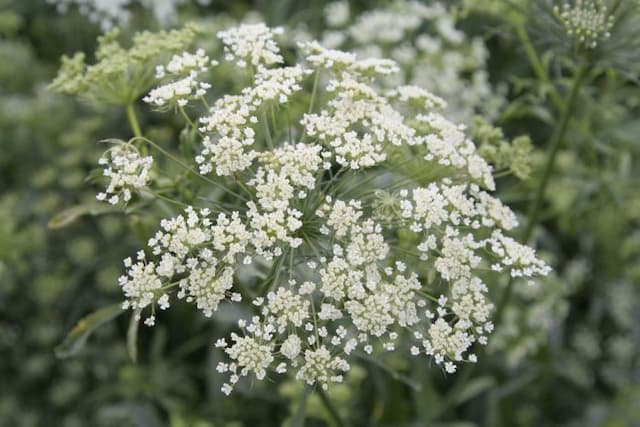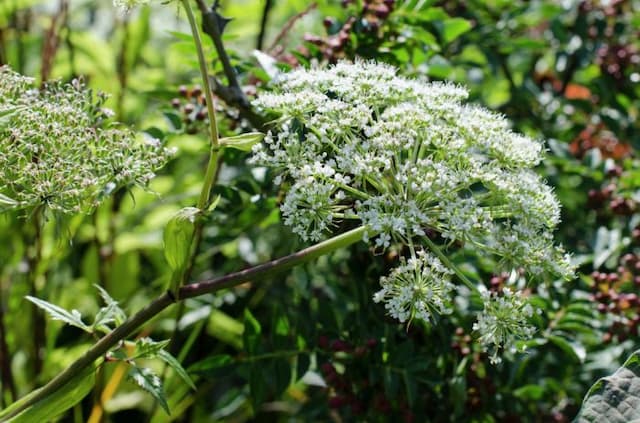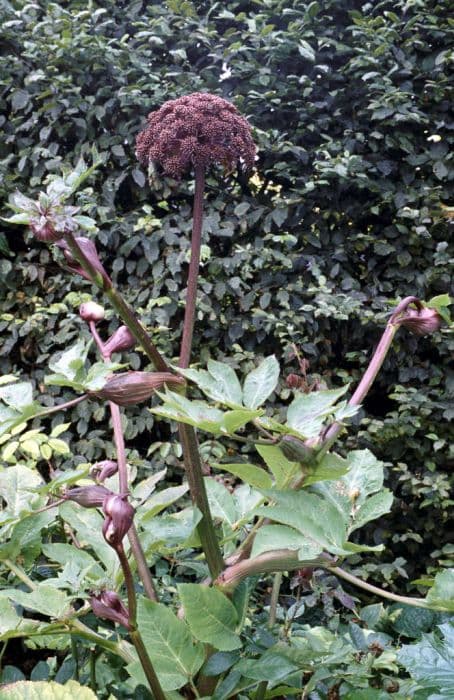Great Masterwort Astrantia major 'Pink Sensation'

ABOUT
Astrantia major 'Pink Sensation', commonly known as Great Masterwort, is an ornamental perennial known for its unique and captivating flower heads. The plant features a bounty of delicate and intricate pincushion-like blooms. These flowers possess a soft pink hue, providing a gentle and appealing splash of color to any garden space. Surrounding the central, dome-shaped clusters of tiny flowers are prominent bracts that have a papery feel, resembling a collar that can be a shade lighter in color, giving the flowers a star-like appearance. The foliage of Great Masterwort is deeply lobed and palmate, meaning that it resembles an open hand with fingers spreading out from the palm. The leaves are typically lush green with a somewhat serrated edge, which forms an attractive mound beneath the striking blooms. The stems that support the flowers are slender and branching, lifting the blooms above the foliage and creating a layered effect in the plant's overall visual presentation. Overall, Great Masterwort 'Pink Sensation' exudes a sense of whimsy and charm, with its blend of soft pink tones and lacy green leaves, providing an enchanting addition to partially shaded garden settings.
About this plant
 Names
NamesFamily
Apiaceae
Synonyms
Great Masterwort, Masterwort, Hattie's Pincushion, Melancholy Gentleman
Common names
Astrantia major 'Pink Sensation'.
 Toxicity
ToxicityTo humans
Great Masterwort (Astrantia major 'Pink Sensation') is not commonly listed as a poisonous plant to humans. There are no well-known toxic effects or symptoms of poisoning associated with ingestion of any parts of this plant in humans. However, as with any plant, it's generally a good idea to avoid ingesting parts of plants not known to be edible due to potential individual allergic reactions or unknown compounds.
To pets
Great Masterwort (Astrantia major 'Pink Sensation') is also not commonly listed as a poisonous plant to pets such as cats and dogs. There are no widely recognized symptoms of poisoning from this plant in pets. While it is not believed to be toxic, it is advisable to prevent pets from consuming non-food plants to avoid potential gastrointestinal upset or any unexpected allergic responses.
 Characteristics
CharacteristicsLife cycle
Perennials
Foliage type
Deciduous
Color of leaves
Green
Flower color
Pink
Height
2 feet 0.6 meters
Spread
1.5 feet 0.45 meters
Plant type
Herb
Hardiness zones
5
Native area
Europe
Benefits
 General Benefits
General Benefits- Aesthetic Appeal: Adds visual interest to gardens with its striking pink flowers.
- Attracts Pollinators: Welcomes beneficial insects like bees and butterflies that aid in pollination.
- Low Maintenance: Requires minimal care once established, making it ideal for busy gardeners.
- Drought Tolerance: Capable of surviving in dry conditions after it is well-established.
- Long Blooming Period: Provides color and interest in the garden from early summer to early fall.
- Cut Flower Garden Use: Flowers are excellent for cutting and using in floral arrangements.
- Deer Resistance: Less likely to be eaten by deer, ensuring its beauty lasts throughout the season.
- Shade Tolerance: Can perform well in partial shade, offering flexibility in garden placement.
- Cottage Garden Style: Contributes to a classic cottage garden look with its charming blooms.
- Rabbit Resistance: Tends to be avoided by rabbits, which helps to keep the garden intact.
 Medical Properties
Medical PropertiesThis plant is not used for medical purposes.
 Air-purifying Qualities
Air-purifying QualitiesThis plant is not specifically known for air purifying qualities.
 Other Uses
Other Uses- Astrantia major 'Pink Sensation', commonly known as Masterwort, can be used as a natural fabric dye, giving textiles a delicate pink hue derived from its pink flowers.
- Ink making: The pigments in Masterwort flowers can be utilized to create botanical inks for art or writing, offering a unique shade of pink.
- Photography: The intricate details and unique color of Masterwort blooms are excellent subjects for macro photography, allowing photographers to explore plant structure.
- Decorative Pressed Flowers: The flowers of Masterwort can be pressed and used in art projects, such as bookmarks or greeting cards, maintaining their shape and color when dried.
- Culinary Garnish: The flower heads can serve as an edible garnish for salads and desserts, providing an interesting visual appeal.
- Floral Arrangements: Masterwort's showy flowers and long-lasting cut stems make it a popular choice in both fresh and dried floral arrangements.
- Biodegradable Confetti: The petals can be used as a natural and biodegradable confetti for outdoor celebrations, reducing environmental impact.
- Botanical Illustration: Artists may use Masterwort as a subject for botanical illustration, capturing its form and color in detail.
- Garden Design: Masterwort can be used in moon gardens, where its pale pink flowers can reflect moonlight and create a luminous display at night.
- Natural Potpourri: Dried Masterwort flowers can be incorporated into potpourri mixes to add color and a light, natural fragrance to a room.
Interesting Facts
 Feng Shui
Feng ShuiThe plant Astrantia is not used in Feng Shui practice.
 Zodiac Sign Compitability
Zodiac Sign CompitabilityThe plant Astrantia is not used in astrology practice.
 Plant Symbolism
Plant Symbolism- Magic and Enchantment: Astrantia, commonly known as Masterwort, is often associated with magic and enchantment due to its unique star-like bracts and intricate blossoms that seem to be right out of a fairy tale or magical woodland scene.
- Protection: Historically, Masterwort was used in herbal medicines and believed to have protective properties. It was sometimes used in spells or carried as an amulet to guard against harm.
- Perseverance and Strength: The hardy nature of Masterwort symbolizes perseverance and the ability to withstand challenges, much like the plant itself which thrives in various conditions and retains beauty amongst other garden plants.
- Secrets and Complexity: The complex structure of Masterwort blooms signifies secrets and mysteries, reflecting the hidden depths and layers that are waiting to be discovered within a person or situation.
 Water
WaterGreat masterworts like 'Pink Sensation' thrive in moist, well-drained soil. They should be watered deeply once a week, giving the soil a chance to partly dry out between watering sessions. During the growing season, ensure that they receive about one inch of water weekly, which is roughly equivalent to about half a gallon per square foot. It's essential to avoid overwatering, as this can lead to root rot. During hotter, drier periods, increase watering frequency to maintain consistent soil moisture.
 Light
LightMasterwort prefers partial to full shade conditions for optimal growth. 'Pink Sensation' should be placed in a spot where it receives filtered sunlight or morning sun with afternoon shade. Avoiding intense, direct sunlight particularly during the summer months will help protect the leaves from scorching.
 Temperature
TemperatureMasterwort thrives in temperatures between 45°F and 85°F and can tolerate a range between 40°F to 90°F. 'Pink Sensation' is hardy and can sustain brief periods of colder temperatures, but prolonged exposure to temperatures below 40°F may be harmful. Ideal temperature conditions would be consistently within the preferred range, particularly during its growing season.
 Pruning
PruningPruning is necessary for masterwort 'Pink Sensation' to remove spent flowers and to encourage further blooming. Deadheading the faded blooms throughout the summer can promote a cleaner plant appearance. Additionally, prune back the foliage in late fall or early spring to maintain plant health and shape. Optimal pruning time is after the main blooming period or in early spring before new growth begins.
 Cleaning
CleaningAs needed
 Soil
SoilMasterwort 'Pink Sensation' thrives in moist, fertile, well-drained soil with a pH of 5.8 to 6.8. A mix of garden soil, compost, and leaf mold or peat moss can create an ideal growing medium for this plant.
 Repotting
RepottingMasterwort 'Pink Sensation' does not need frequent repotting; repot every 2-3 years or when the plant has outgrown its container, usually in spring.
 Humidity & Misting
Humidity & MistingMasterwort 'Pink Sensation' prefers moderate to high humidity levels but is adaptable and can tolerate a range of humidity conditions in a garden setting without any special requirements.
 Suitable locations
Suitable locationsIndoor
Use well-draining soil and ensure good light.
Outdoor
Plant in partial shade, moist, fertile soil.
Hardiness zone
4-7 USDA
 Life cycle
Life cycleThe Masterwort 'Pink Sensation' (Astrantia major 'Pink Sensation') begins its life cycle with seed germination, typically in early spring, after which the seedlings develop into young plants with a basal rosette of leaves. With favorable light, moisture, and temperature conditions, the plant enters a vegetative stage where it produces more leaves and stems, growing steadily in size and vigor. After reaching maturity, the Masterwort 'Pink Sensation' produces distinctive pink pincushion-like flowers surrounded by papery bracts, generally in late spring to early summer. When the flowering period is over, usually in late summer, the plant sets seeds that are dispersed by wind, water, or animals. Following seed dispersal, the plant may enter a dormant phase, particularly in climates with cold winters, where the above-ground foliage dies back and the plant survives with its perennial root system. Each spring, the cycle recommences with new growth from the surviving roots, continuing the perennation of the Masterwort 'Pink Sensation'.
 Propogation
PropogationPropogation time
Early Spring
The most popular method of propagation for Astrantia major 'Pink Sensation', or Great Masterwort, is by division. This should typically be done in the spring. To propagate by division, carefully dig up an established clump of Great Masterwort and gently separate the root mass into smaller sections, ensuring that each new segment has a part of the root system and some shoots. These divided sections can then be immediately replanted in moist, well-drained soil at the same depth they were originally growing. Make sure each new plant has adequate space to grow, and water them thoroughly after replanting to help establish the new divisions. It may take some time for the divisions to recover from the transplant shock and begin growing vigorously.









